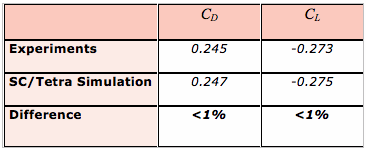Latest News
June 21, 2010
By Yuya Ando, Software Cradle
Predicting ground vehicle drag (CD) and lift (CL) is an extremely challenging benchmark for assessing CFD accuracy. The Japanese Society of Automotive Engineers (JSAE) collected drag and lift data for a 1/5 scale vehicle design submitted from an Ideas Competition for a Low Drag Car1. A 3D computer model was provided to eight CFD developers/suppliers to determine how well CFD can predict zero-degree yaw drag and lift.
Software Cradle used its SC/Tetra, unstructured grid, general-purpose CFD software, to construct a 20M element model. The model took 40 minutes to generate the mesh using a computer not much bigger than what most people have at home. The steady state model used a k-w shear-stress transport turbulence model. The solution took just over two days to complete using an eight-processor CPU and 3.5GB of RAM.
Results were submitted to JSAE for comparison with the experimental measurements. This was not a data-matching exercise where the model parameters were tuned to match the experimental data. Model predictions were submitted without knowing the measured values of CD and CL. Results are shown in the following table.
As can be seen, SC/Tetra, using the advanced k-w shear-stress turbulence model, predicted both CD and CL within 1% of the measured values. This was well within the noise level of the experimental measurements2.
The accuracy of a CFD simulation are usually application dependent, and well-controlled validation tests are always recommended
1 The CFD committee (ed.), Geometry Data of Model Vehicle Used in Wind Tunnel Testing for Prospective CFD Benchmark Tests (in Japanese), Technical Report Series, JSAE, No.42, (2008).
2 Shimano, K. Et al., Wind Tunnel Testing of JSAE Standard Low- aerodynamic-drag Vehicle Body Using 1/5 Scale Model, Review of Automotive Engineering, Vol. 30, No.1, (2009).
Subscribe to our FREE magazine, FREE email newsletters or both!
Latest News
About the Author
DE’s editors contribute news and new product announcements to Digital Engineering.
Press releases may be sent to them via [email protected].







